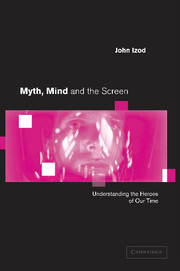Book contents
- Frontmatter
- Contents
- Acknowledgments
- Introduction
- 1 Jungian theory, textual analysis and audience play
- 2 Archetypal images: signification and the psyche
- 3 Archetypal images: symbols and the cultural unconscious
- 4 The Piano, the animus and colonial experience
- 5 The pop star as icon
- 6 The quest of a female hero: The Silence of the Lambs
- 7 Television sport and the sacrificial hero
- 8 The polycentred self: The Passion of Darkly Noon
- 9 Haunted: searching for the whole self
- 10 Transforming the final ghost: the god within
- Conclusion
- Filmography
- Glossary of Jungian and related terms
- References
- Index
10 - Transforming the final ghost: the god within
Published online by Cambridge University Press: 22 September 2009
- Frontmatter
- Contents
- Acknowledgments
- Introduction
- 1 Jungian theory, textual analysis and audience play
- 2 Archetypal images: signification and the psyche
- 3 Archetypal images: symbols and the cultural unconscious
- 4 The Piano, the animus and colonial experience
- 5 The pop star as icon
- 6 The quest of a female hero: The Silence of the Lambs
- 7 Television sport and the sacrificial hero
- 8 The polycentred self: The Passion of Darkly Noon
- 9 Haunted: searching for the whole self
- 10 Transforming the final ghost: the god within
- Conclusion
- Filmography
- Glossary of Jungian and related terms
- References
- Index
Summary
In the iconography of myth, ghosts have interesting first and second cousins in UFOs (Unidentified Flying Objects) and fictional spaceships respectively. They are related, of course, through their signifieds rather than their signifiers (their connotations rather than their looks): and it was the mythological connections of flying saucers that engaged Jung's interest in the 1950s. During that decade many sightings were claimed and these phenomena attracted much public attention.
Jung argued that the UFOs of that era were a collective manifestation of the fears aroused in western nations by the Cold War. Indeed, although he did not use the term, he was in effect showing how the cultural unconscious could energise and launch a symbolic cluster with archetypal roots that responded to the pressures of the time. Demonstrating that such images have a history which at the very least reaches back to the sixteenth century, he wrote an amplification not only of reports of sightings but also of their images and associated ideas. He showed how, whatever other passengers they might be suspected of conveying, flying saucers were most certainly carriers of archetypal energies.
Among other factors, he considered the pervasive nature of geometric and numeric symbolism associated with the UFOs, and demonstrated how the same symbolism traditionally represented images of divinity (Jung 1959c: 406–7). He also found that the masculine–feminine antithesis occurred in some graphic descriptions of UFOs, with, in one case, cigar-shaped objects opposed to others that took a saucer or lens form (ibid.: 350).
- Type
- Chapter
- Information
- Myth, Mind and the ScreenUnderstanding the Heroes of our Time, pp. 185 - 203Publisher: Cambridge University PressPrint publication year: 2001



